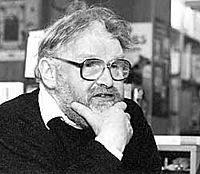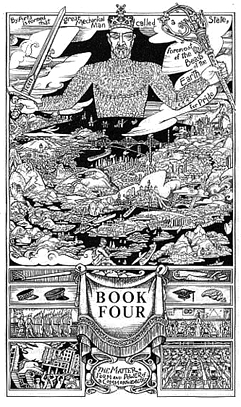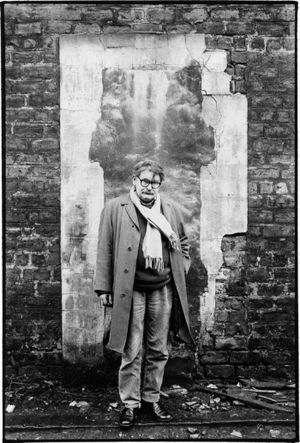Alasdair Gray facts for kids
Quick facts for kids
Alasdair Gray
|
|
|---|---|

Alasdair Gray in 1994
|
|
| Born | 28 December 1934 Riddrie, Glasgow, Scotland |
| Died | 29 December 2019 (aged 85) Shieldhall, Glasgow, Scotland |
| Occupation | Novelist, artist, playwright, academic, teacher, poet, muralist, illustrator |
| Nationality | Scottish |
| Alma mater | Glasgow School of Art |
| Genre | Science fiction, dystopianism, surrealism, realism |
| Literary movement | Postmodern literature |
| Years active | 1951–2019 |
| Notable works | Lanark: A Life in Four Books 1982, Janine Poor Things The Book of Prefaces |
| Spouse |
Inge Sørensen
(m. 1961; separated 1969)Morag McAlpine
(m. 1991; died 2014) |
| Children | 1 |
| Website | |
| Official website: http://joemurray.me.uk/alasdairgray/ Alasdair Gray Archive |
|
Alasdair James Gray (28 December 1934 – 29 December 2019) was a Scottish writer and artist. His first novel, Lanark (1981), is seen as a landmark of Scottish fiction. He published novels, short stories, plays, poetry and translations, and wrote on politics and the history of English and Scots literature. His works of fiction combine realism, fantasy, and science fiction with the use of his own typography and illustrations, and won several awards.
He studied at Glasgow School of Art from 1952 to 1957. As well as his book illustrations, he painted portraits and murals, including one at the Òran Mór venue and one at Hillhead subway station. His artwork has been widely exhibited and is in several important collections. Before Lanark, he had plays performed on radio and TV.
His writing style is postmodern and has been compared with those of Franz Kafka, George Orwell, Jorge Luis Borges and Italo Calvino. It often contains extensive footnotes explaining the works that influenced it. His books inspired many younger Scottish writers, including Irvine Welsh, Alan Warner, A. L. Kennedy, Janice Galloway, Chris Kelso and Iain Banks. He was writer-in-residence at the University of Glasgow from 1977 to 1979, and professor of Creative Writing at Glasgow and Strathclyde Universities from 2001 to 2003.
Gray was a Scottish nationalist and a republican, and wrote supporting socialism and Scottish independence. He popularised the epigram "Work as if you live in the early days of a better nation" (taken from a poem by Canadian poet Dennis Lee) which was engraved in the Canongate Wall of the Scottish Parliament Building in Edinburgh when it opened in 2004. He lived almost all his life in Glasgow, married twice, and had one son. On his death The Guardian referred to him as "the father figure of the renaissance in Scottish literature and art".
Early life
Gray's father, Alexander, had been wounded in the First World War. He worked for many years in a factory making boxes, often went hillwalking, and helped found the Scottish Youth Hostels Association. Gray's mother was Amy (née Fleming), whose parents had moved to Scotland from Lincolnshire because her father had been blacklisted in England for trade union membership. She worked in a clothing warehouse. Alasdair Gray was born in Riddrie in north-east Glasgow on 28 December 1934; his sister Mora was born two years later. During the Second World War, Gray was evacuated to Auchterarder in Perthshire, and Stonehouse in Lanarkshire. From 1942 until 1945 the family lived in Wetherby in Yorkshire, where his father was running a hostel for workers in ROF Thorp Arch, a munitions factory.
Gray frequently visited the public library; he enjoyed the Winnie-the-Pooh stories, and comics like The Beano and The Dandy. Later, Edgar Allan Poe became a powerful influence on the young Gray. His family lived on a council estate in Riddrie, and he attended Whitehill Secondary School, where he was made editor of the school magazine and won prizes for Art and English. When he was eleven Gray appeared on BBC children's radio reading from an adaptation of one of Aesop's Fables, and he started writing short stories as a teenager. His mother died of cancer when he was eighteen; in the same year he enrolled at Glasgow School of Art. As an art student he began what later became his first novel, Lanark, which originally carried the name Portrait of the Artist as a Young Scot. He completed the first book in 1963; it was rejected by the Curtis Brown literary agency. It was originally intended to be Gray's version of A Portrait of the Artist as a Young Man.
In 1957 Gray graduated from art school with a degree in Design and Mural Painting. That year he won a Bellahouston Travelling scholarship, and intended to use it to paint and see galleries in Spain. A severe asthma attack left him hospitalised in Gibraltar, and he had his money stolen. From 1958–1962 Gray worked part-time as an art teacher in Lanarkshire and Glasgow, and in 1959–1960 he studied teaching at Jordanhill College.
Visual art

After finishing art school, Gray painted theatrical scenery for the Glasgow Pavilion and Citizens Theatres, and worked as a freelance artist. His first mural was "Horrors of War" for the Scottish-USSR Friendship Society in Glasgow. In 1964 the BBC made a documentary film, Under the Helmet, about his career to date. Many of his murals have been lost; surviving examples include one in the Ubiquitous Chip restaurant in the West End of Glasgow, and another at Hillhead subway station. His ceiling mural (in collaboration with Nichol Wheatley) for the auditorium of the Òran Mór venue on Byres Road is one of the largest works of art in Scotland and was painted over several years. It shows Adam and Eve embracing against a night sky, with modern people from Glasgow in the foreground.
In 1977–1978, Gray worked for the People's Palace museum, as Glasgow's "artist recorder", funded by a scheme set up by the Labour government. He produced hundreds of drawings of the city, including portraits of politicians, people in the arts, members of the general public and workplaces with workers. These are now in the collection at Kelvingrove Art Gallery and Museum.
In 2007 Gray began working with gallerist Sorcha Dallas who, over the 14 years they worked together, developed interest in his visual practice brokering sales to major collections including the Arts Council of England, the Scottish National Galleries and the Tate. His paintings and prints are also held in Glasgow Museums, the Victoria and Albert Museum, the National Library of Scotland and the Hunterian Museum.
In 2014-2015 Dallas devised the Alasdair Gray Season, a citywide celebration of Gray's visual work to coincide with his 80th birthday. The main exhibition, Alasdair Gray: From The Personal To The Universal, was held at the Kelvingrove Art Gallery and Museum with over 15,000 attending.
His first solo London exhibition took place in late 2017 at the Coningsby Gallery in Fitzrovia and the Leyden Gallery in Spitalfields.
Gray said that he found writing tiring, but that painting gave him energy. His visual art often used local or personal details to encompass international or universal truths and themes.
Writing

Gray's first plays were broadcast on radio (Quiet People) and television (The Fall of Kelvin Walker) in 1968. Between 1972 and 1974 he took part in a writing group organised by Philip Hobsbaum, which included James Kelman, Tom Leonard, Liz Lochhead, Aonghas MacNeacail and Jeff Torrington. In 1973, with the support of Edwin Morgan, he received a grant from the Scottish Arts Council to allow him to continue with Lanark. From 1977 to 1979 he was writer-in-residence at the University of Glasgow.
Lanark, his first novel, was published in 1981 to great acclaim, and became his best-known work. Lanark has been compared with Franz Kafka and Nineteen Eighty-Four by George Orwell for its atmosphere of bureaucratic threat, and with Jorge Luis Borges and Italo Calvino for its fabulism. It revivified Scottish literature, inspired a new generation of Scottish writers, including Irvine Welsh, Alan Warner, A. L. Kennedy, Janice Galloway and Iain Banks, and has been called "one of the landmarks of 20th-century fiction", but it did not make Gray wealthy. His first short-story collection, Unlikely Stories, Mostly, won the Cheltenham Prize for Literature in 1983. It is a selection of Gray's short fiction from 1951–1983.
Around 2000, Gray had to apply to the Scottish Artists' Benevolent Association for financial support, as he was struggling to survive on the income from his book sales. In 2001 Gray, Kelman and Leonard became joint professors of the Creative Writing programme at Glasgow and Strathclyde Universities.
Gray's books are mainly set in Glasgow and other parts of Scotland. His work helped strengthen and deepen the development of the Glasgow literary scene. Gray's work, particularly Lanark, "put Scotland back on the literary map", and strongly influenced Scottish fiction for decades.
His books are self-illustrated.
He published three collections of poetry; like his fiction, his poems are sometimes-humorous depictions of "big themes" like love, God and language.
Personal life
Gray married Inge Sørensen, a nurse from Denmark, in 1961. They had a son, Andrew, in 1963, and separated in 1969.
He had an eight-year relationship with Danish jeweller Bethsy Gray and was married to Morag McAlpine from 1991 until her death in 2014.
He lived in Glasgow his entire adult life.
Death and legacy
Alasdair Gray died at Queen Elizabeth University Hospital on 29 December 2019, the day after his 85th birthday, following a short illness. He left his body to science and there was no funeral.
Nicola Sturgeon, first minister of Scotland, remembered him as "one of the brightest intellectual and creative lights Scotland has known in modern times." Tributes were also paid by Jonathan Coe, Val McDermid, Ian Rankin, Ali Smith and Irvine Welsh. The Guardian referred to him as "the father figure of the renaissance in Scottish literature and art". His works are archived at the National Library of Scotland.
Sorcha Dallas was responsible for packing and organising his items posthumously and establishing the Alasdair Gray Archive in March 2020. The Archive is a free community resource caring for Gray's studio and visual and literary materials. It commissions new works, offers access and education opportunities as well as partnering on projects and events. One such event is Gray Day, held annually on 25 February in celebration of Gray's life and works.
See also
 In Spanish: Alasdair Gray para niños
In Spanish: Alasdair Gray para niños


